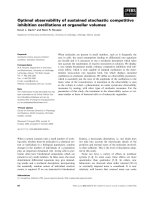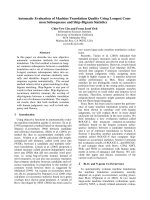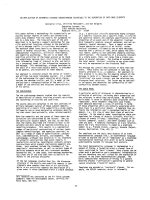Báo cáo khoa học: "An Exploration of Forest-to-String Translation: Does Translation Help or Hurt Parsing?" ppt
Bạn đang xem bản rút gọn của tài liệu. Xem và tải ngay bản đầy đủ của tài liệu tại đây (220.09 KB, 5 trang )
Proceedings of the 50th Annual Meeting of the Association for Computational Linguistics, pages 317–321,
Jeju, Republic of Korea, 8-14 July 2012.
c
2012 Association for Computational Linguistics
An Exploration of Forest-to-String Translation:
Does Translation Help or Hurt Parsing?
Hui Zhang
University of Southern California
Department of Computer Science
David Chiang
University of Southern California
Information Sciences Institute
Abstract
Syntax-based translation models that operate
on the output of a source-language parser have
been shown to perform better if allowed to
choose from a set of possible parses. In this
paper, we investigate whether this is because it
allows the translation stage to overcome parser
errors or to override the syntactic structure it-
self. We find that it is primarily the latter, but
that under the right conditions, the transla-
tion stage does correct parser errors, improv-
ing parsing accuracy on the Chinese Treebank.
1 Introduction
Tree-to-string translation systems (Liu et al., 2006;
Huang et al., 2006) typically employ a pipeline of
two stages: a syntactic parser for the source lan-
guage, and a decoder that translates source-language
trees into target-language strings. Originally, the
output of the parser stage was a single parse tree, and
this type of system has been shown to outperform
phrase-based translation on, for instance, Chinese-
to-English translation (Liu et al., 2006). More recent
work has shown that translation quality is improved
further if the parser outputs a weighted parse forest,
that is, a representation of a whole distribution over
possible parse trees (Mi et al., 2008). In this paper,
we investigate two hypotheses to explain why.
One hypothesis is that forest-to-string translation
selects worse parses. Although syntax often helps
translation, there may be situations where syntax, or
at least syntax in the way that our models use it, can
impose constraints that are too rigid for good-quality
translation (Liu et al., 2007; Zhang et al., 2008).
For example, suppose that a tree-to-string system
encounters the following correct tree (only partial
bracketing shown):
(1) [
NP
j
¯
ıngj
`
ı
economy
z
¯
engzh
ˇ
ang]
growth
de
DE
s
`
ud
`
u
rate
‘economic growth rate’
Suppose further that the model has never seen this
phrase before, although it has seen the subphrase
z¯engzhˇang de s`ud`u ‘growth rate’. Because this sub-
phrase is not a syntactic unit in s entence (1), the sys-
tem will be unable to translate it. But a forest-to-
string system would be free to choose another (in-
correct but plausible) bracketing:
(2) j
¯
ıngj
`
ı
economy
[
NP
z
¯
engzh
ˇ
ang
growth
de
DE
s
`
ud
`
u]
rate
and successfully translate it using rules learned from
observed data.
The other hypothesis is that forest-to-string trans-
lation selects better parses. For example, if a Chi-
nese parser is given the input c¯anji¯a biˇaojiˇe de h¯unlˇı,
it might consider two structures:
(3) [
VP
c
¯
anji
¯
a
attend
bi
ˇ
aoji
ˇ
e]
cousin
de
DE
h
¯
unl
ˇ
ı
wedding
‘wedding that attends a cousin’
(4) c
¯
anji
¯
a
attend
[
NP
bi
ˇ
aoji
ˇ
e
cousin
de
DE
h
¯
unl
ˇ
ı]
wedding
‘attend a cousin’s wedding’
The two structures have two different translations
into English, shown above. While the parser prefers
structure (3), an n-gram language model would eas-
ily prefer translation (4) and, therefore, its corre-
sponding Chinese parse.
317
(a)
f f f
parser
−−−−→
f f f
decoder
−−−−−→ e e e e
source source target
string tree string
(b)
f f f
parser
−−−−→
f f f
decoder
−−−−−→ e e e e
source source target
string forest string
Figure 1: (a) In tree-to-string translation, the parser gen-
erates a single tree which the decoder must use to gen-
erate a translation. (b) In forest-to-string translation, the
parser generates a forest of possible trees, any of which
the decoder can use to generate a translation.
Previous work has shown that an observed target-
language translation can improve parsing of source-
language text (Burkett and Klein, 2008; Huang et al.,
2009), but to our knowledge, only Chen et al. (2011)
have explored the case where the target-language
translation is unobserved.
Below, we carry out experiments to test these
two hypotheses. We measure the accuracy (using
labeled-bracket F1) of the parses that the translation
model selects, and find that they are worse than the
parses selected by the parser. Our basic conclusion,
then, is that the parses that help translation (accord-
ing to Bleu) are, on average, worse parses. That is,
forest-to-string translation hurts parsing.
But there is a twist. Neither labeled-bracket F1
nor Bleu is a perfect metric of the phenomena it is
meant to measure, and our translation system is op-
timized to maximize Bleu. If we optimize our sys-
tem to maximize labeled-bracket F1 instead, we find
that our translation system selects parses that score
higher than the baseline parser’s. That is, forest-to-
string translation can help parsing.
2 Background
We provide here only a cursory overview of tree-
to-string and forest-to-string translation. For more
details, the reader is referred to the original papers
describing them (Liu et al., 2006; Mi et al., 2008).
Figure 1a illustrates the tree-to-string transla-
tion pipeline. The parser stage can be any phrase-
structure parser; it computes a parse for each source-
language string. The decoder stage translates the
source-language tree into a target-language string,
using a synchronous tree-substitution grammar.
In forest-to-string translation (Figure 1b), the
parser outputs a forest of possible parses of each
source-language string. The decoder uses the same
rules as in tree-to-string translation, but is free to se-
lect any of the trees contained in the parse forest.
3 Translation hurts parsing
The simplest experiment to carry out is to exam-
ine the parses actually selected by the decoder, and
see whether they are better or worse than the parses
selected by the parser. If they are worse, this sup-
ports the hypothesis that syntax can hurt translation.
If they are better, we can conclude that translation
can help parsing. In this initial experiment, we find
that the former is the case.
3.1 Setup
The baseline parser is the Charniak parser (Char-
niak, 2000). We trained it on the Chinese Treebank
(CTB) 5.1, split as shown in Table 1, following
Duan et al. (2007).
1
The parser outputs a parse forest
annotated with head words and other information.
Since the decoder does not use these annotations,
we use the max-rule algorithm (Petrov et al., 2006)
to (approximately) sum them out. As a side bene-
fit, this improves parsing accuracy from 77.76% to
78.42% F1. The weight of a hyperedge in this for-
est is its posterior probability, given the input string.
We retain these weights as a feature in the translation
model.
The decoder stage is a forest-to-string system (Liu
et al., 2006; Mi et al., 2008) for Chinese-to-English
translation. The datasets used are listed in Ta-
ble 1. We generated word alignments with GIZA++
and symmetrized them using the grow-diag-final-
and heuristic. We parsed the Chinese side using
the Charniak parser as described above, and per-
formed forest-based rule extraction (Mi and Huang,
2008) with a maximum height of 3 nodes. We used
the same features as Mi and Huang (2008). The
language model was a trigram model with modi-
fied Kneser-Ney smoothing (Kneser and Ney, 1995;
Chen and Goodman, 1998), trained on the target
1
The more common split, used by Bikel and Chiang (2000),
has flaws that are described by Levy and Manning (2003).
318
Parsing Translation
Train CTB 1–815 FBIS
CTB 1101–1136
Dev CTB 900–931 NIST 2002
CTB 1148–1151
Test CTB 816–885 NIST 2003
CTB 1137–1147
Table 1: Data used for training and testing the parsing and
translation models.
Parsing Translation
System Objective F1% Bleu%
Charniak n/a 78.42 n/a
tree-to-string max-Bleu 78.42 23.07
forest-to-string max-Bleu 77.75 24.60
forest-to-string max-F1 78.81 19.18
Table 2: Forest-to-string translation outperforms tree-to-
string translation according to Bleu, but the decreases
parsing accuracy according to labeled-bracket F1. How-
ever, when we train to maximize labeled-bracket F1,
forest-to-string translation yields better parses than both
tree-to-string translation and the original parser.
side of the training data. We used minimum-error-
rate (MER) training to optimize the feature weights
(Och, 2003) to maximize Bleu.
At decoding time, we select the best derivation
and extract its source tree. In principle, we ought
to sum over all derivations for each source tree; but
the approximations that we tried (n-best list crunch-
ing, max-rule decoding, minimum Bayes risk) did
not appear to help.
3.2 Results
Table 2 shows the main results of our experiments.
In the second and third line, we see that the forest-
to-string system outperforms the tree-to-string sys-
tem by 1.53 Bleu, consistent with previously pub-
lished results (Mi et al., 2008; Zhang et al., 2009).
However, we also find that the trees selected by the
forest-to-string system score much lower according
to labeled-bracket F1. This suggests that the reason
the forest-to-string system is able to generate better
translations is that it can soften the constraints im-
posed by the syntax of the source language.
4 Translation helps parsing
We have found that better translations can be ob-
tained by settling for worse parses. However, trans-
lation accuracy is measured using Bleu and pars-
ing accuracy is measured using labeled-bracket F1,
and neither of these is a perfect metric of the phe-
nomenon it is meant to measure. Moreover, we op-
timized the translation model in order to maximize
Bleu. It is known that when MER training is used
to optimize one translation metric, other translation
metrics suffer (Och, 2003); much more, then, can
we expect that optimizing Bleu will cause labeled-
bracket F1 to suffer. In this section, we try optimiz-
ing labeled-bracket F1, and find that, in this case, the
translation model does indeed select parses that are
better on average.
4.1 Setup
MER training with labeled-bracket F1 as an objec-
tive function is straightforward. At each iteration of
MER training, we run the parser and decoder over
the CTB dev set to generate an n-best list of possible
translation derivations (Huang and Chiang, 2005).
For each derivation, we extract its Chinese parse tree
and compute the number of brackets guessed and
the number matched against the gold-standard parse
tree. A trivial modification of the MER trainer then
optimizes the feature weights to maximize labeled-
bracket F1.
A technical challenge that arises is ensuring di-
versity in the n-best lists. The MER trainer re-
quires that each list contain enough unique transla-
tions (when maximizing Bleu) or source trees (when
maximizing labeled-bracket F1). However, because
one source tree may lead to many translation deriva-
tions, the n-best list may contain only a few unique
source trees, or in the extreme case, the derivations
may all have the same source tree. We use a variant
of the n-best algorithm that allows efficient genera-
tion of equivalence classes of derivations (Huang et
al., 2006). The standard algorithm works by gener-
ating, at each node of the forest, a list of the best
subderivations at that node; the variant drops a sub-
derivation if it has the same source tree as a higher-
scoring subderivation.
319
Maximum
rule height F1%
3 78.81
4 78.93
5 79.14
LM data
(lines) F1%
none 78.78
100 78.79
30k 78.67
300k 79.14
13M 79.24
Features F1%
monolingual 78.89
+ bilingual 79.24
Parallel data
(lines) F1%
60k 78.00
120k 78.16
300k 79.24
(a) (b) (c) (d)
Table 3: Effect of variations on parsing performance. (a) Increasing the maximum translation rule height increases
parsing accuracy further. (b) Increasing/decreasing the language model size increases/decreases parsing accuracy.
(c) Decreasing the parallel text size decreases parsing accuracy. (d) Removing all bilingual features decreases parsing
accuracy, but only slightly.
4.2 Results
The last line of Table 2 shows the results of this
second experiment. The system trained to opti-
mize labeled-bracket F1 (max-F1) obtains a much
lower Bleu score than the one trained to maximize
Bleu (max-Bleu)—unsurprisingly, because a single
source-side parse can yield many different transla-
tions, but the objective function scores them equally.
What is more interesting is that the max-F1 system
obtains a higher F1 score, not only compared with
the max-Bleu system but also the original parser.
We then tried various settings to investigate what
factors affect parsing performance. First, we found
that increasing the maximum rule height increases
F1 further (Table 3a).
One of the motivations of our method is that bilin-
gual information (especially the language model)
can help disambiguate the source side structures. To
test this, we varied the size of the corpus used to train
the language model (keeping a maximum rule height
of 5 from the previous experiment). The 13M-line
language model adds the Xinhua portion of Giga-
word 3. In Table 3b we see that the parsing perfor-
mance does increase with the language model size,
with the largest language model yielding a net im-
provement of 0.82 over the baseline parser.
To test further the importance of bilingual infor-
mation, we compared against a system built only
from the Chinese side of the parallel text (with each
word aligned to itself). We removed all features that
use bilingual information, retaining only the parser
probability and the phrase penalty. In their place
we added a new feature, the probability of a rule’s
source side tree given its root label, which is essen-
tially the same model used in Data-Oriented Parsing
(Bod, 1992). Table 3c shows that this system still
outperforms the original parser. In other words, part
of the gain is not attributable to translation, but ad-
ditional source-side context and data that the trans-
lation model happens to capture.
Finally, we varied the size of the parallel text
(keeping a maximum rule height of 5 and the largest
language model) and found that, as expected, pars-
ing performance correlates with parallel data size
(Table 3d).
5 Conclusion
We set out to investigate why forest-to-string trans-
lation outperforms tree-to-string translation. By
comparing their performance as Chinese parsers, we
found that forest-to-string translation sacrifices pars-
ing accuracy, suggesting that forest-to-string trans-
lation works by overriding constraints imposed by
syntax. But when we optimized the system to max-
imize labeled-bracket F1, we found that, in fact,
forest-to-string translation is able to achieve higher
accuracy, by 0.82 F1%, than the baseline Chinese
parser, demonstrating that, to a certain extent, forest-
to-string translation is able to correct parsing errors.
Acknowledgements
We are grateful to the anonymous reviewers for
their helpful comments. This research was sup-
ported in part by DARPA under contract DOI-NBC
D11AP00244.
320
References
Daniel M. Bikel and David Chiang. 2000. Two statis-
tical parsing models applied to the Chinese Treebank.
In Proc. Second Chinese Language Processing Work-
shop, pages 1–6.
Rens Bod. 1992. A computational model of language
performance: Data Oriented Parsing. In Proc. COL-
ING 1992, pages 855–859.
David Burkett and Dan Klein. 2008. Two languages
are better than one (for syntactic parsing). In Proc.
EMNLP 2008, pages 877–886.
Eugene Charniak. 2000. A maximum-entropy-inspired
parser. In Proc. NAACL, pages 132–139.
Stanley F. Chen and Joshua Goodman. 1998. An empir-
ical study of smoothing techniques for language mod-
eling. Technical Report TR-10-98, Harvard University
Center for Research in Computing Technology.
Wenliang Chen, Jun’ichi Kazama, Min Zhang, Yoshi-
masa Tsuruoka, Yujie Zhang, Yiou Wang, Kentaro
Torisawa, and Haizhou Li. 2011. SMT helps bitext
dependency parsing. In Proc. EMNLP 2011, pages
73–83.
Xiangyu Duan, Jun Zhao, and Bo Xu. 2007. Probabilis-
tic models for action-based Chinese dependency pars-
ing. In Proc. ECML 2007, pages 559–566.
Liang Huang and David Chiang. 2005. Better k-best
parsing. In Proc. IWPT 2005, pages 53–64.
Liang Huang, Kevin Knight, and Aravind Joshi. 2006.
Statistical syntax-directed translation with extended
domain of locality. In Proc. AMTA 2006, pages 65–
73.
Liang Huang, Wenbin Jiang, and Qun Liu. 2009.
Bilingually-constrained (monolingual) shift-reduce
parsing. In Proc. EMNLP 2009, pages 1222–1231.
Reinhard Kneser and Hermann Ney. 1995. Improved
backing-off for M-gram language modeling. In Proc.
ICASSP 1995, pages 181–184.
Roger Levy and Christopher D. Manning. 2003. Is it
harder to parse Chinese, or the Chinese Treebank? In
Proc. ACL 2003, pages 439–446.
Yang Liu, Qun Liu, and Shouxun Lin. 2006. Tree-to-
string alignment template for statistical machine trans-
lation. In Proc. COLING-ACL 2006, pages 609–616.
Yang Liu, Yun Huang, Qun Liu, and Shouxun Lin. 2007.
Forest-to-string statistical translation rules. In Proc.
ACL 2007, pages 704–711.
Haitao Mi and Liang Huang. 2008. Forest-based trans-
lation rule extraction. In Proc. EMNLP 2008, pages
206–214.
Haitao Mi, Liang Huang, and Qun Liu. 2008. Forest-
based translation. In Proc. ACL-08: HLT, pages 192–
199.
Franz Josef Och. 2003. Minimum error rate training
in statistical machine translation. In Proc. ACL 2003,
pages 160–167.
Slav Petrov, Leon Barrett, Romain Thibaux, and Dan
Klein. 2006. Learning accurate, compact, and inter-
pretable tree annotation. In Proc. COLING-ACL 2006,
pages 433–440.
Min Zhang, Hongfei Jiang, Aiti Aw, Haizhou Li,
Chew Lim Tan, and Sheng Li. 2008. A tree se-
quence alignment-based tree-to-tree translation model.
In Proc. ACL-08: HLT, pages 559–567.
Hui Zhang, Min Zhang, Haizhou Li, Aiti Aw, and
Chew Lim Tan. 2009. Forest-based tree sequence to
string translation model. In Proc. ACL-IJCNLP 2009,
pages 172–180.
321









